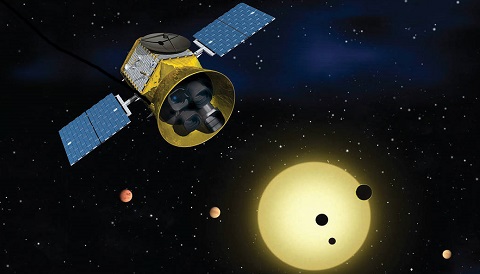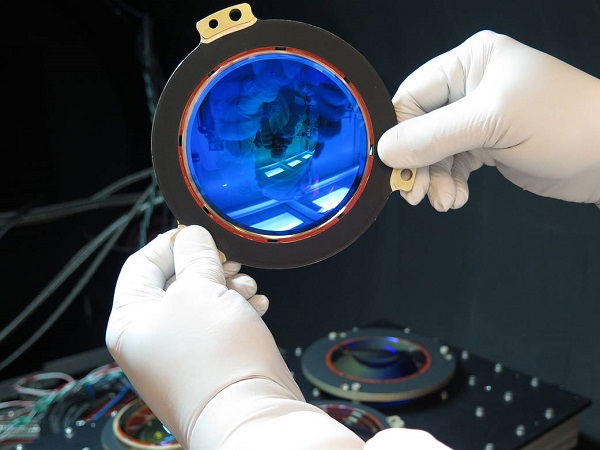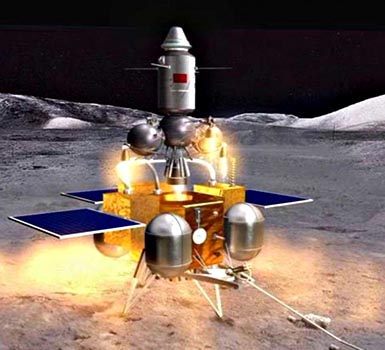An exciting year lies ahead for science and planetary spaceflight — by NASA and by other spacefaring nations.

NASA
What does the coming year hold in store for planetary science and astronomy missions? While very few planetary-science missions will launch in 2017, we do have a new exoplanet hunter, a lunar-sample return, a space weather satellite, and an X-ray telescope headed into orbit.
Farther afield, the Cassini mission at Saturn comes to a dramatic end this year, Juno spends an entire year at Jupiter, and the OSIRIS-Rex mission makes a close 12,500-mile (20,000-km) flyby past our planet on September 22nd en route to arrival at asteroid 101955 Bennu in August 2018.
First, a recap. 2016 saw 86 space launches worldwide, two of which — ESA's Mars Trace Gas Orbiter and NASA's OSIRIS-REx asteroid sample return mission — were dedicated to solar-system exploration. Last year started with the launch of the ill-fated Japanese Hitomi X-ray observatory on February 17th, followed by the launch of the ExoMars Trace Gas Orbiter from the Baikonur Cosmodrome on March 14th. Other high profile launches for the year included Russia's Mikhailo Lomonosov gamma-ray observatory on April 28th and OSIRIS-REx on September 8th.
We also saw Rosetta wrap up its mission as it came to rest on Comet 67P/Churyumov-Gerasimenko, NASA's Juno spacecraft arrive at Jupiter, and the ExoMars Trace Gas Orbiter reach Mars. Although TGO was a huge success, the joint ESA/Roscosmos Schiaparelli lander that hitched a ride with TGO did not fare as well, slamming into the Red Planet's surface on October 19th.
2017: A Space Exploration Odyssey

NASA/MIT Lincoln Laboratory
The big mission of the year is NASA's Transiting Exoplanet Survey Satellite (TESS), with a projected launch window running from December 2017 to June 2018. TESS is set to revolutionize exoplanet science. TESS is the first all-sky exoplanet survey satellite. Kepler only stared at a patch sky along the Cygnus/Lyra/Hercules region, and then later along a swath of the ecliptic during its extended K2 mission.
To accomplish its mission, TESS will enter a highly inclined elliptical orbit in a 2:1 resonance with the Moon, a first for any space mission. This will afford TESS an unobstructed view of the entire celestial sphere. In contrast to previous surveys which were only sensitive to large transiting 'hot Jupiter' worlds, TESS will target more than 200,000 stars searching for small rocky worlds transiting the host primary star for possible follow up by the James Webb Space Telescope (JWST). TESS has a 2-year-long primary mission.

NASA / UC Berkeley
Next up, the Ionospheric Connection Explorer launches on June 15th. ICON is headed for low Earth orbit, where the satellite equipped with four instruments (an interferometer, an ion velocity meter, and two ultraviolet detectors) will probe the upper ionosphere in an attempt to model and understand the complex dynamics at play near the boundary between space weather from above and terrestrial weather systems below. A team from the University of California at Berkeley leads the mission, which is part of NASA's Explorer Program and Heliophysics Division. ICON will launch on a Pegasus XL rocket carried aloft by Orbital Science's Stargazer L-1011 aircraft flying out of Kwajalein Atoll in the Pacific. Here's what such a hybrid launch looks like:
This year China is also set to launch its first space-based astronomical observatory: the Hard X-ray Modulation Telescope. HXMT will cover the spectral range from 20,000 to 200,000 electron volts (20–200 keV), seeking emissions from black holes, neutron stars, and other sources of hard X-rays and gamma rays. HXMT should launch atop a Long March 2D rocket from China's Jiuquan Satellite Launch Center in early 2017, and it joins NuSTAR, Chandra, and the European Space Agency's XMM-Newton as probes of the X-ray universe.

CCTV
China may also launch Chang'e 5 in late 2017 atop a new heavy-lift rocket, the Long March 5. An ambitious mission, Chang'e 5 will land on the Moon and return to Earth with 2 kilograms of lunar regolith. The mission is unique in that the lunar departure module will — much like the Apollo missions — conduct an automated rendezvous with the return vehicle in lunar orbit. The Jade Rabbit lander plus rover and the Chang'e 5 T1 reentry capsule test carried out in 2014 were precursors leading up to the sample-return mission. This will make China the third nation to return samples from the Moon, following the United States and the former Soviet Union.
Why the lull in new planetary missions in 2017? Well, a majority of these spacecraft head to Mars, and we're in between opposition years for the Red Planet. Earth and Mars reach an ideal launch geometry about every 26 months leading up to opposition, as will happen again next year.
What's up beyond 2017? The big story in 2018 will be the launch (finally!) of the James Webb Space Telescope. Mars InSight spacecraft also launches in 2018, after having been postponed a little more than a year ago.. Also watch for NASA's Solar Probe Plus and Solar Orbiter missions and ESA's Mercury-bound BepiColombo orbiter. Finally, New Horizons expects to fly past Kuiper Belt object 2014 MU69 at close range on New Year's Day, 2019.
Get ready for another great year of space exploration!
 0
0









Comments
You must be logged in to post a comment.